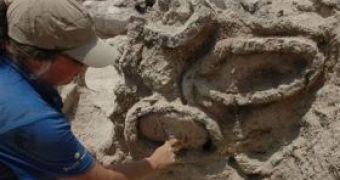Human taste for honey is millions of years old. Baboons and chimpanzees are known to indulge with honey when they find a bee colony.
Cave paintings dated 15,000 years old found in South Africa and India depict honey hunting by Paleolithic people. In Cava D'Arana, discovered in 1919 in Valencia region (Spain), there is a special scene of prehistoric honey hunt, 9,000 years old, a type of hunt still practiced in Himalaya, Africa, southern Arabia and southeastern Asia.
Cave paintings dated 13,000 years old already present beekeeping. In Turkey, near the locality of Cital-Guyuk, the 7,000 years old ruins of a house have on the walls some frescos showing scenes from the life of the bees.
The ancient Mayans even venerated a bee-god, named Ah Muzen Cab.
Now, archaeologists have dug in northern Israel remains of a 3,000-year-old beekeeping industry, including what's left of ancient honeycombs, beeswax and the oldest intact ever discovered beehives.
"The findings in the ruins of the city of Rehov this summer include 30 intact hives dating to around 900 B.C.," archaeologist Amihai Mazar of Jerusalem's Hebrew University told The Associated Press.
"It offers unique evidence that an advanced honey industry existed in the Holy Land at the time of the Bible. Beekeeping was widely practiced in the ancient world, where honey used for medicinal and religious purposes as well as for food, and beeswax was used to make molds for metal and to create surfaces to write on. While bees and beekeeping are depicted in ancient artwork, nothing similar to the Rehov hives has ever been found before," Mazar said.
"The beehives, made of straw and unbaked clay, have a hole at one end to allow the bees in and out and a lid on the other end to allow beekeepers access to the honeycombs inside. They were found in orderly rows, three high, in a room that could have accommodated around 100 hives," he added.
Israel is often named in the Bible as a "land of milk and honey," but it was largely thought that this referred to "honey" made from dates and figs, as the book does not mention honeybee cultivation. The new discovery shows that indeed, 3,000 years ago, the Holy Land harbored an extensive beekeeping industry. By those times, Rehov could have had around 2,000 inhabitants, mostly Canaanites (the ancient Jews came from a Canaanite population).
"You can tell that this was an organized industry, part of an organized economy, in an ultra-organized city," Mazar said. "The finding was a unique glimpse into ancient beekeeping. We have seen depictions of beekeeping in texts and ancient art from the Near East, but this is the first time we've been able to actually feel and see the industry," said Ezra Marcus, an expert on the ancient Mediterranean world at Haifa University, not involved in this research.
"The finding is especially unique, because of its location in the middle of a thriving city - a strange place for thousands of bees. This might have been because the city's ruler wanted the industry under his control, or because the beekeeping industry was linked to residents' religious practices, as might be indicated by an altar decorated with fertility figurines that archaeologists found alongside the hives," added Marcus.

 14 DAY TRIAL //
14 DAY TRIAL //